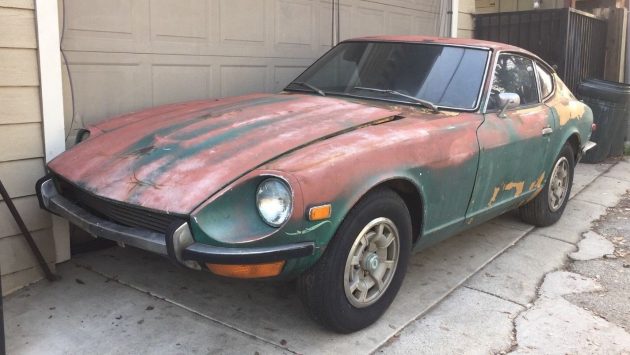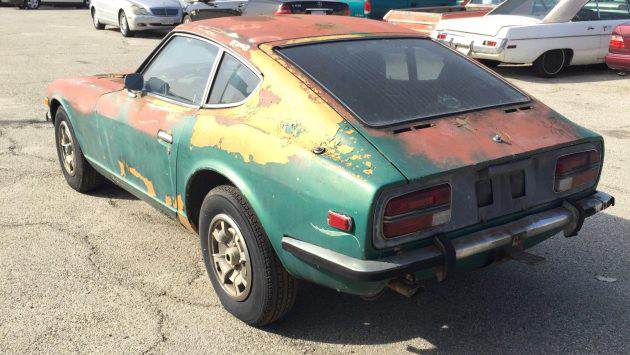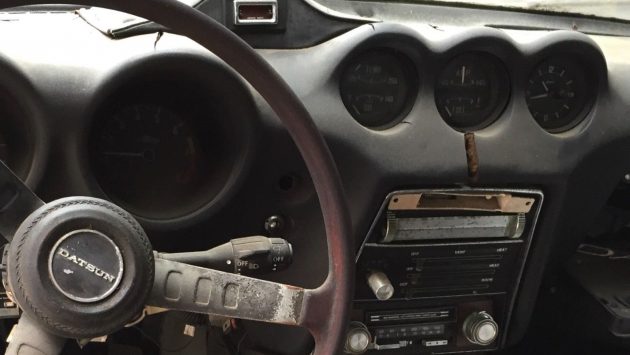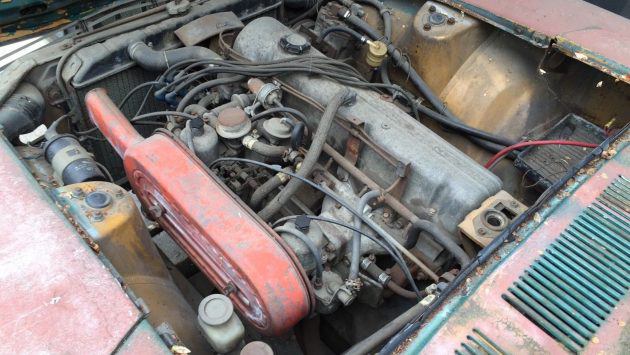This 1970 Datsun 240Z is a desirable early-model example that retains its numbers-matching engine paired to a four-speed manual. Its cosmetics are tired but the car isn’t rusty, and a low VIN number indicates early production. The seller is facing an impending move and the realizatio he won’t complete the project. Find it here on eBay with active bidding approaching $10K and no reserve.
I don’t know about you, but this is the kind of car I’d want to buy if I was hell-bent on a Z project. The seller says long-time desert storage means it is largely rust-free, save for a few small spots that he’ll include replacement metal for: “The rust is located on the passenger side by the gas door, and in the rear hatch / spare tire area due to a bad seal.”
Now, the downside to the dry climate is a sun-baked interior, and the dash is heavily cracked and in general, the cosmetics are quite tired. Surprisingly, the lone picture of the driver’s seat shows decent vinyl surfaces; no picture of the passenger seat is included. It looks to retain an original or at least period-correct radio; the interior color is the original black while outside it wore gold when new.
The seller says the engine doesn’t currently run but does turn over by hand. While the gear does move through the gears, its condition is similarly unknown. Bidders are sometimes good indicators of the market recognizing a solid car when they see one, so I’m not surprised to see the high level of activity on this 240Z.






Lot of great pictures in the Ebay ad. Anybody here know if these had a late 1969 production build date ?
The eBay listing has a photo of the FMVSS plate that gives a manufacture date of 1/70.
As a DIY project, this has a lot of potential, but I’m unsure of what its market value is, stateside, these days.
The 240Z was a game-changer for Nissan – great cars!
The ’70 was the best Z since it wasn’t loaded with anti-pollution equipment like the later models. Equipped with am/fm radio, it sold for around $2000, beating all rivals. In 1973, they were detuned and by 1975, had more CI to counter the reduced HP. Heavy crash required bumpers didn’t help. I bought a ’72, probably the best year. Great trouble free car but needed power steering.
A VW Beetle sold for about 2k back then (actually $1999). Pretty sure the Z sold for well north of 3K.
Same wheels as on the subject car, and I have never seen this style on a Z before!
Those are 280z hubcaps.
To answer a few questions….
The ’70 models listed for about $3600 but often had a total cost some hundreds higher because dealers often (i.e., almost always) installed extras like “mag” (aluminum) wheels, wider tires, stripes, door bump strips, and other things. That even happened without your requesting it if you were on a waiting list, since if you didn’t want the car the next guy on the wait list usually would. They were VERY popular cars back in ’70 – ’72.
The early cars like this one came with an AM-only radio, but it was a quality Hitachi signal-seeking radio, and the cars also came with an electric aerial that could be raised and lowered.
The earliest production cars had very late 1969 production dates, but if you check the driver’s door jamb VIN plate you can see that this car was produced in 1/70 (January ’70), so even before 1000 cars had been built they had build dates into the early ’70s months.
Actually, the procedures and kinks were still being worked out then, and the very early cars differed in many little ways from even late 1970-produced cars, which actually makes them more desirable to Z car fanatics. I have a list of about 40 differences between the earliest cars and cars made in late 1970 and 1971.
Beatnick is right. This car has great potential, which is why it has been bid to nearly $10K with 2 days to go in the auction. And it has LOTS of needs. These cars rarely rust in the spare tire well, but this one did. The (very) good news is that the frame looks really good, relatively speaking, in the front wheel wells. Rust there can be a big problem with these cars.
But there are no photos of the floors, and they can rust right through, and often do. So I would expect that in this car. Fortunately, excellent reproduction floors and stiffeners are available.
Excellent original or properly restored early cars usually sell in the $35K to $55K range or even a bit higher now depending on how well they were preserved or restored. This car is worth restoring but it will take a lot of work and cash. I know, because I’m doing an even earlier car right now.
But if you can do a lot of the work yourself, and if you can get good metalwork and paint for a reasonable price, say no more than about $15K, you should do OK with this car. They are still appreciating, and will probably continue to for a good while.
I remember 1970 well as I got back from Nam and later got married. Before I was drafted, I worked at a body shop which did the repair on new cars for a Datsun dealership. Many had light shipping damage. I lived with the shop owner for 2 plus months and helped out be picking up and delivering Datsuns.
I was amazed at the supplemental stickers applied to these cars; ADM (Additional Dealer Markup) of $500 or $600 plus paint sealant, bumper bars, floor mats, mud guards, luggage racks, and more. They still sold instantly. Some paid for the luggage rack but didn’t want installed with holes in the trunk lid.
I think they also applied and charged for rust “proofing” but the early “Zs” rusted quickly in Central ohio.
Good buddy of mine in college had one of these back in the day, bought it new. It was that Butterscotch color that so many came in. We had a blast tooling around town in that thing. A great testament to the interior space was the fact that even though he was 6-5 he had no problem with head and legroom. Bet he wishes he still had it.
I was the proud owner of a “71 Datsun 240Z. I think the “240” referred to the engine size of 2400cc. Never knew the HP rating, but the thing would haul. Never seemed to wind up after 1st gear. I05 mph. in 3rd gear according to the speedometer. May have been only 95 or even 85…who knows.
The picture shows 2 carbs. I thought mine had 3, but it’s been a long time.
Anyway, drove it well over 200K miles and sold it for $1500 with everything in the drive train and suspension worn completely out.
It was great to be young and foolish.
Great comment Bob. I also had a Z car, an early ’70, back close to when they were new.
The ‘240’ does refer to just under 2400 cc displacement. The early cars were rated at 150 HP, but they were so light (about 2300 pounds) it seemed like they had more power than that. My car also topped out in 3rd gear at about 100 MPH and would get to about 122 or a little more in 4th gear before running out of steam.
These early cars had 2 Hitachi carbs that were based on the design of the SU carbs that came on so many of the British sportscars before F.I. got to be common.
I once built a triple-Hitachi setup for my first ’70 Z car back in the day. My father in law owned a foundry and cast the aluminum manifolds for me. The car ran even stronger with the 3 Hitachis but it was a chore to keep it in tune, so I went back to the original twin Hitachi carb setup.
Sometimes it’s not worth trying to outdo the Japanese at something they do real well.
That was the year I was learning that Datsun made cool sports cars. I read a favorable review of their 2000 convertible, a direct competitor to the British sports cars my brother and I both favored. Then the 240Z came out, to great reviews. I’ve always loved its body styling, and still do. It is classic, with a touch of something new about it. I hope somebody restores this one. Sure, put a third SU carburettor on it!